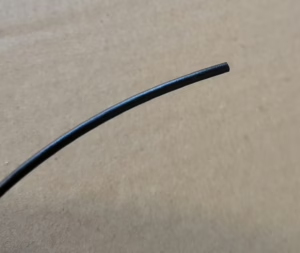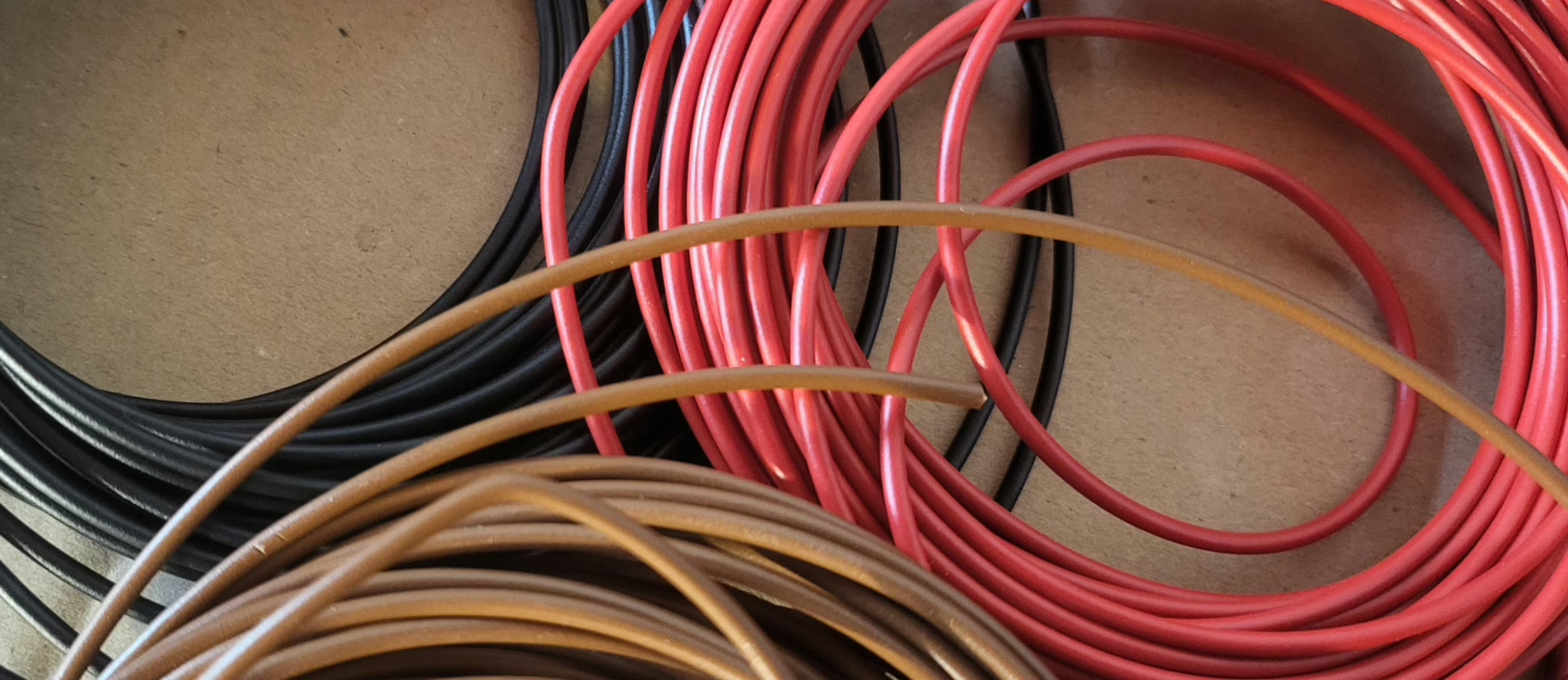FLRY-B vehicle cables: Retrofit tips and vehicle electrics
-
10. April 2025
FLRY-B-cable
Anyone working in automotive electrics - whether professional or ambitious hobby mechanic - can hardly avoid FLRY-B cables. These flexible, heat-resistant cables are standard in modern vehicles and ideal for retrofitting, repairs or self-built wiring harnesses. But what makes FLRY-B so special? What cross-section is needed for what amperage? And what is the best way to lay the cable? You'll find all the answers in this article.
What is a FLRY-B cable?
The designation FLRY-B is made up as follows:
F = Fahrzeugleitung(Vehicle line)
L = Leitung(Electrical cable)
R = reduziert (dünnwandige Isolierung)(reduced (thin-walled insulation))
Y = PVC-Isolation(PVC insulation)
B = flexible, feindrähtige Kupferlitze(flexible, finely stranded copper wire)
FLRY-B cables are designed for use in vehicle interiors, where they stand out thanks to their thin insulation, high flexibility and temperature resistance (-40 °C to +105 °C). This makes them ideal for tight installation spaces and complex cable harnesses.
Which cross-section for which application?
The cross-section of a cable determines how much current can flow safely. Here is a rough overview for FLRY-B cables:
| Cross section | Max. current (approx.) | Typical use |
|---|---|---|
| 0,5 mm² | up to 5 A | Sensor cables, LED, small consumers |
| 0,75 mm² | up to 8 A | Control lines, relay control |
| 1,0 mm² | up to 10 A | Light, ignition, small motors |
| 1,5 mm² | up to 15 A | Power windows, central locking |
| 2,5 mm² | up to 20 A | Power consumers, auxiliary heaters |
| 4,0 mm² | up to 25-30 A | On-board power supply, main power lines |
Tip: Always adapt the fuse protection (e.g. fuse holder) to the cable cross-section. For longer cables, also calculate the voltage loss.
Current load for longer cables
| Current / power in amperes | 3 m | 5 m | 8 m | 10 m | 12 m | 14 m | 16 m |
|---|---|---|---|---|---|---|---|
| 3 A | 1,5 mm² | 1,5 mm² | 1,5 mm² | 1,5 mm² | 1,5 mm² | 2,5 mm² | 2,5 mm² |
| 6 A | 1,5 mm² | 1,5 mm² | 2,5 mm² | 2,5 mm² | 4 mm² | 4 mm² | 4 mm² |
| 9 A | 1,5 mm² | 2,5 mm² | 4 mm² | 4 mm² | 4 mm² | 6 mm² | 6 mm² |
| 12 A | 2,5 mm² | 4 mm² | 4 mm² | 6 mm² | 6 mm² | 10 mm² | 10 mm² |
| 15 A | 2,5 mm² | 4 mm² | 6 mm² | 6 mm² | 10 mm² | 10 mm² | 10 mm² |
| 18 A | 4 mm² | 4 mm² | 6 mm² | 10 mm² | 10 mm² | 10 mm² | 16 mm² |
| 21 A | 4 mm² | 6 mm² | 10 mm² | 10 mm² | 10 mm² | 16 mm² | 16 mm² |
| 24 A | 4 mm² | 6 mm² | 10 mm² | 10 mm² | 16 mm² | 16 mm² | 16 mm² |
| 27 A | 4 mm² | 6 mm² | 10 mm² | 10 mm² | 16 mm² | 16 mm² | 16 mm² |
| 30 A | 6 mm² | 10 mm² | 10 mm² | 16 mm² | 16 mm² | 16 mm² | 25 mm² |
Installation in the vehicle - how to do it right
Correct installation is particularly important for retrofitting or conversions:
Protection against chafing: Always protect with Corrugated tube, Fabric tube or PVC hose especially in the engine compartment or with moving parts (e.g. door lead-throughs).
Fastening: Always use Cable ties, Clips or Clamps to fix in place, never leave hanging loose.
Ground connection: Ensure that the grounding points are clean - bare metal, well deburred and protected against corrosion.
Lengths and reserve: Always plan a little reserve - better too long than too short.
Retain color coding: Makes troubleshooting much easier later on.
Standard colors and their meaning
There is no uniform standard in vehicle construction as there is for NYM cables in the home - but the following colors are common in many vehicles:
| Color | Typical function |
|---|---|
| Brown | Ground |
| Red | Permanent plus |
| Black | ignition plus |
| Green | Signal line (sensors etc.) |
| Light blue | Indicator lights |
| Gray | Parking light |
| ORANGE | ATTENTION: The high-voltage cables are orange as standard! Dangerous high voltage |
| *The colors shown are for guidance only, as there are many exceptions due to the lack of standards. |
Important: When converting, it is best to keep the color code or document it - e.g. with shrink-wrap labeling or labels.

Practical example: Retrofitting an auxiliary headlight*
Do you want to retrofit auxiliary headlights? Then you need:
2,5 mm² FLRY-B (red) for Permanent plus
1,0 mm² FLRY-B (yellow or green) for control via relay
1,5 mm² FLRY-B (brown) for ground
Fuse holder (e.g. 15 A), or pin for fuse box
Relay with matching socket
Shrink tubing & protective tubing
This keeps the system safe, maintainable and durable.
*This is only a rough guide, not a manual, there are other things to consider when working on the electrical system.
Are you planning a retrofit?
Get in touch by e-mail or contact form with your project to receive a quote for cables in various colors, including multicolored.
Data bus cables, e.g. Can-Bus or loudspeaker cables, can also be supplied.
Relays, fuses, switches, pins, headlights or even seat heaters and the like can also be supplied.
If you provide us with a detailed description of your project, we will also send you a wiring diagram as a PDF with a recommendation for connecting your retrofit after you have purchased the material.
FAQ - Frequently asked questions about FLRY-B cables
What is the difference between FLRY-A and FLRY-B?
FLRY-A has a rigid, thicker strand. FLRY-B is more flexible and therefore ideal for tight radii and moving areas.
Can FLRY-B cables be used in the engine compartment?
Basically yes - if additional protection against heat and vibration, e.g. through heat protection hoses is given.
Are FLRY-B cables available in different colors and lengths?
Yes, they are available in many colors and mostly by the meter - also here in the store.
How do I determine the current carrying capacity of a cable?
It depends on the Cross section, the Länge and the Location (ventilated or tightly laid). You can find rough guide values above.
Which crimp connectors are suitable for FLRY-B?
Make sure you have suitable sleeves or butt connectors for fine stranded wires - ideally with shrink tubing and adhesive.
Conclusion
FLRY-B cables are real all-rounders in vehicle wiring. Whether you are building a new wiring harness, retrofitting additional modules or simply want to replace a defective cable - with the right cross-section, matching color and clean installation, you are always on the safe side.

